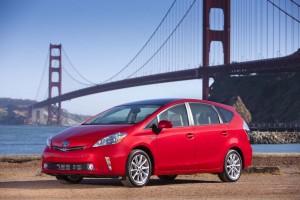
Record demand for the expanding Prius "family," including the Prius Vshown here, helped nudge U.S. fuel economy to a record 24.1 mpg.
The fuel economy of the average new vehicle sold in the United States has topped 24 miles per gallon for the first time ever, according to researchers at the University of Michigan Transportation Research Institute.
Using the numbers shown in the “Munroney” window sticker, he average fuel economy of the cars, light trucks, minivans and SUVs purchased in March rose to 24.1 mpg, up from 23.9 in February and 23.6 in January.
The typical vehicle sold in March 2012 was 20%, or four miles per gallon, higher than the industry average in October 2007, the first month UMTRI researchers Michael Sivak and Brandon Schoettle began tracking vehicle mileage.
The surge in fuel economy should be no surprise to those who have been tracking recent sales trends. Small cars have enjoyed a major surge as gas prices have begun their latest push towards record levels. Compact and smaller models now account for nearly a quarter of the market, up from less than 18% as recently as last December.
Meanwhile, hybrid-electric vehicles have also enjoyed a big burst of interest, the Toyota Prius achieving record sales in March.
(New study finds hybrid owners less than loyal, most trading in for non-hybrids. Click Here for more.)
In addition to reporting on the average fuel economy numbers, researchers Sivak and Schoettle issued their monthly update of their national Eco-Driving Index, which estimates the average monthly emissions generated by an individual U.S. driver. The EDI takes into account both vehicle fuel economy and distance driven—the latter relying on data that are published with a two-month lag.
During January, the EDI stood at 0.83, an improvement from 0.86 in December (the lower the value, the better). The index currently shows that emissions of greenhouse gases per driver of newly purchased vehicles are down 17%, overall, since October 2007.
In addition, Sivak and Schoettle reported the unadjusted Corporate Average Fuel Economy performance for the first time. That figure is not the same as the number consumers see because it is based on a different set of EPA ratings. Nonetheless, it also showed a substantial improvement For March. The unadjusted CAFE figure rose to 29.6 mpg, an increase of 20%, or 4.9 mpg, since October 2007.
What remains to be seen is whether the surge in fuel economy will continue once fuel prices level off. Most analysts believe the trend will continue, however, if for no other reason than the tough new fuel economy standards automakers are facing. That has led the industry to make major shifts in powertrain technology that will continue to have an impact for years to come.
